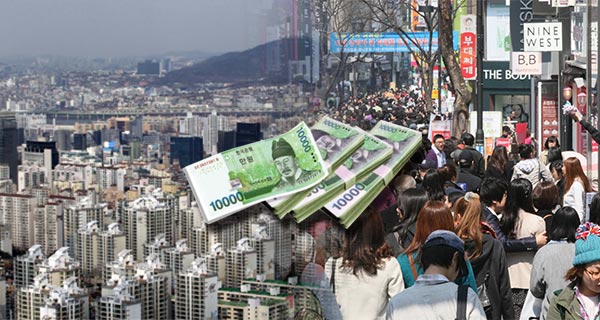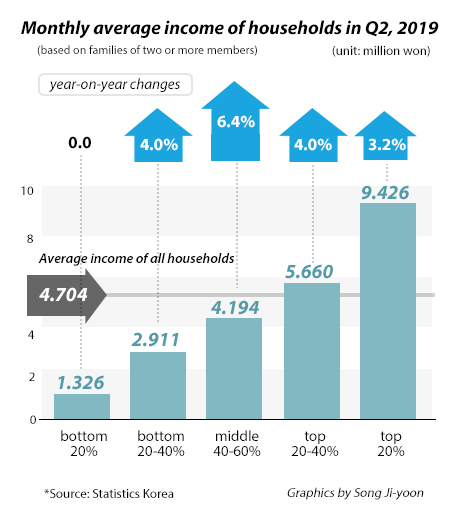
이 누리집은 대한민국 공식 전자정부 누리집입니다.

Biz News Korea(Eng)
- Collected
- 2019.08.22
- Distributed
- 2019.08.23
- Source
- Go Direct

South Korea’s income disparity has widened to the worst since data was tracked from 2003 in the second quarter as improvements for the poor class failed to catch up with faster gains of the richer, data showed Thursday.
According to data released by Statistics Korea, the average monthly nominal income of households with two or more members in the bottom 20 percent bracket came to 1.33 million won ($1,099) in the April-June period, up 0.04 percent from the same period a year ago. Although marginal, it is the first income increase in six quarters for the bottom-income quintile.
The monthly average income for the bottom 20 percent bracket deteriorated five consecutive quarters – 8 percent in the first quarter of last year, 7.6 percent in the second quarter, 7 percent in the third quarter, 17.7 percent in the fourth quarter, and 2.5 percent in the first quarter of this year.
Although, monthly earned income of households in the bottom 20 percent bracket fell 15.3 percent in the second quarter, similar to 15.9 percent in the same period a year ago, their business income increased 15.8 percent this year, managing a small increase compared to a 21 percent fall last year. Their income also was helped by transfer income (social benefits) increase of 9.7 percent in the April-June period, data showed.

Still the wealth polarization worsened as income at the richer gained faster. The average nominal income of the top income bracket rose 3.2 percent to 9.4 million won in the second quarter, mainly led by a 4 percent increase in earned income.
The average nominal income of households belonging to the bottom 20 to 40 percent bracket gained 4 percent in the second quarter from the same period last year while that of those belonging to the 40 to 60 percent bracket 6.4 percent, and 20 to 40 percent 4 percent, remaining above 3.8 percent average growth of all households during the period.
Data also showed that nominal disposable income of all households rose 2.7 percent in the second quarter ended June, the largest gain since 3.1 percent in the second quarter of 2015. Disposable income in the bottom 20 percent income bracket, however, dropped 1.3 percent in the April-June period, falling for a sixth consecutive quarter since the first quarter of last year.
With household income for the bottom 20 percent bracket showing little improvement as to that for top income bracket, income disparity worsened to the worst level since the agency began compiling related data in 2003.
Korea’s distribution ratio for disposable income stood at 5.3 in the second quarter, up from 5.23 in the same period last year, hitting the highest level for the quarter since 2003.
Average monthly income of all households, meanwhile, continued to increase.
Data showed that an average household earned 4.7 million won a month in nominal income in the April-June period, up 3.8 percent from a year ago. It is the largest increase since 4.6 percent in the third quarter of 2018. Led by growth in nominal income, real income also increased 3.2 percent during the period, the biggest since 3.9 percent in the first quarter of 2014.
By Sohn Il-seon and Lee Eun-joo
[ⓒ Pulse by Maeil Business News Korea & mk.co.kr, All rights reserved]









